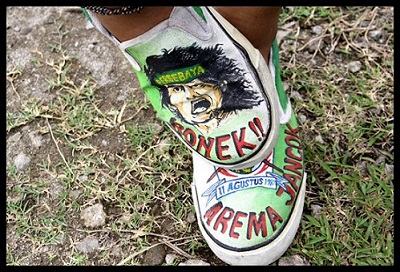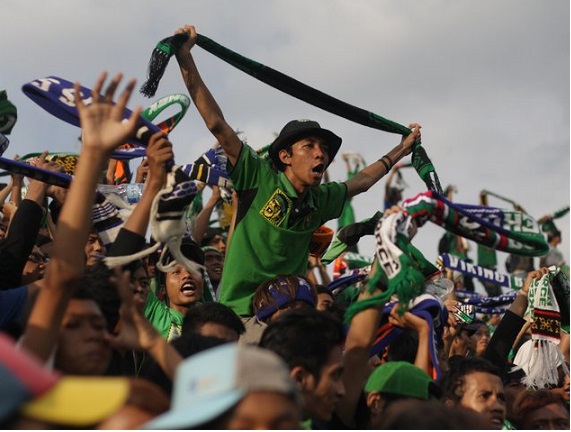Andy Fuller
Bonek members in full flight Hermawan Handaka
Fajar Junaedi’s Bonek: Komunitas Suporter Pertama dan Terbesar di Indonesia (Bonek: The First and Largest Supporter Community in Indonesia) is the first major study of football fans in Indonesia. It examines Bonek, the large and highly visible fan club of Surabaya’s Persebaya soccer team and traces the development of ‘modern soccer fandom’ in Indonesia. Junaedi, an academic based at Universitas Muhamadiyah Yogyakarta, has published widely in Indonesian academic journals.
The early chapters examine the culture of fan hooligans in other parts of the world. While Junaedi draws on numerous English language sources, some of his sources are somewhat dated and the study would have benefited from drawing on more recent studies of soccer fandom elsewhere in the world. He positions Indonesian soccer fandom as being something derivative and ‘western’ or ‘European’.
However, the value of Junaedi’s study becomes clearer when he analyses the specific local conditions that led to the emergence and formation of Bonek which, as the title of his book states, is the first and largest soccer fan ‘grouping’ in Indonesia. One of these factors was the supportive role played by Dahlan Iksan, publisher of Surabaya’s Jawa Pos, one of Indonesia’s largest newspapers. Junaedi shows clearly how Dahlan Iksan expanded his newspaper’s market base by catering to, and stimulating, the hunger of Persebaya fans for comprehensive and detailed news of their team. Jawa Pos also facilitated trips by Bonek members to Jakarta to watch Persebaya play. However, Bonek’s relationship with the media was not always mutually beneficial.
Bonek, the author argues, are a united group of supporters and this differentiates them from other supporter groups. For example, the fans of PSS Sleman and of Yogyakarta’s PSIM are often divided, resulting in internal fighting quite apart from conflict with other clubs’ fans. Bonek’s unity was established in the mid-1980s when Persebaya fans would travel to Jakarta on buses organised by Jawa Pos. These trips became known as Tret…Tret…Tret, being the sound of a group marching. Their unity was also enhanced by their festive cheering and improvised playing of a wide range of musical instruments, particularly drums and trumpets, as well as acoustic guitars for more intimate settings.
The name Bonek comes from Bondo Nekat. Bondo is a Javanese word meaning ‘resource’ and nekat means ‘reckless’. Thus, Bonek are those who live recklessly off minimal resources. This name was given to supporters who would leave Surabaya with little or no money to travel to Jakarta to watch Persebaya play. This quality of ‘recklessness’ is part bravery, part over-commitment and part risk-taking. Their lack of money on the intercity trips has resulted in the ransacking of stalls at train stations. Having no train ticket has not been a problem as the national train operator knows that fans will damage their trains and train stations if they are not allowed to make the trip.
The iconic image of Bonek is the Wong Mangap or Ndas Mangap being a Rambo-like portrait of a man, shouting his anger and support for Persebaya. An image first drawn by Mister Muhtar, mangap means ‘open mouth’ in Javanese. The Wong Mangap image became a device to link Bonek fans with the independence movement. The Persebaya fans, formalised and generalised into ‘Bonek’ are imagined as the inheritors of the spirit of the 1945 independence struggle. The Wong Mangap is imagined as shouting merdeka (freedom), a potent word in contemporary Indonesian politics and the national imagination. The spirit of 1945 is invoked as being the eternal, true and real ‘spirit’ of the nation.
 Wong Mangap as mascot Hermawan Handaka
Wong Mangap as mascot Hermawan Handaka
Bonek, however, have an ambivalent relationship with both the media and the nation. Junaedi argues that while the media was central to the rise and mobilisation of Persebaya fandom, it has also played a role in portraying Bonek fans as being disruptive, violent hooligans. Bonek fans claim that the media only reports the negative, while ignoring what is positive, in that many press reports focus on the violence and riots of soccer fans. Bonek fans argue that violence is framed by the media as being inseparable from being Bonek. The Bonek see their recklessness as indicative of their passion and bravery, and argue that the media sees their recklessness as indicating a hostile and violent attitude to all who oppose them or get in their way.
The Bonek came to prominence during the 1980s and 1990s during the height of the New Order era. This was when many forms of social movements and organisations, such as labour unions, were subject to tight control and often suppressed. Literature and the arts were strictly censored by arts organisations and by writers and artists themselves. Supporting Persebaya offered one way for the urban poor to gather collectively and assert their rights and presence in the streets and public spaces. Because their collective expression was somewhat muted, being directed through football rather than politics, they have remained vulnerable as the Bonek are easily portrayed as disruptors of the peace, have been either pushed or moved towards violence, and have become easy targets of violent and direct policing.
The book concludes with a short chapter on ‘Bonek and Trains’. The author explores the idea that the growth of football, both in Indonesia and elsewhere, was facilitated by the development of rail networks. Perhaps this is one reason why football teams have a longer and stronger history in Java, where the rail network is most developed. The author describes how the rail network has increasingly been used by Bonek as a means to perform their Tret…Tret…Tret travels to matches in other cities. Such travel is fraught with danger, violence and confrontation. Sometimes the violence is directed towards the Bonek fans on the trains, sometimes they are the perpetrators. Junaedi writes that it is only when Bonek fans have been killed as a result of the violence on these intercity trips, that they are regarded as victims, rather than agents of violence.
The book has many weaknesses, particularly a lack of editing to eliminate repetition so as to allow the author to explore more deeply some ideas and issues. Junaedi fails to make the voices of the fans heard. One longs to know, for example, how do supporters become affiliated with Bonek? What does being a Bonek mean to them? He doesn’t touch on their backgrounds, as if their being a ‘uniform group’ doesn’t warrant further inquiry, and that their uniformity and solidarity can in fact be taken at face value. Junaedi also ignores the gendered nature of being a Bonek: there is little or no place for women in his analysis and indeed in Bonek. Nonetheless, Junaedi has given serious consideration to an area of public, national, and popular culture largely ignored in studies of contemporary Indonesian society.
Fajar Junaedi, Bonek: Komunitas Suporter Pertama dan Terbesar di Indonesia, Yogyakarta: Buku Litera 2012.
Andy Fuller <acsfuller@gmail.com> is an Associate Fellow at KITLV, Leiden, The Netherlands. His website is readingsideways.net.
See more Bonek images in our Featured Photo Essay gallery.
